The organisers of the Wildlife Photographer of the Year competition are inviting members of the public to vote for their favourite image.
25 incredible images have been shortlisted that spotlight important stories of nature from across the globe. The photographs were chosen from 38,575 entries across 93 countries.
People can cast their vote either online on the Wildlife Photographer of the Year website, or via the interactive screens inside the exhibition at the Natural History Museum, London.
“Voters will have a challenge to choose from this stunning range of photographs which tell vital stories and connect people to issues across the planet,” says Dr Douglas Gurr, director of the Natural History Museum, London. “We are looking forward to finding out which of these images emerges as the favourite.”
The top five images will be displayed online, joining the winners of the fifty-eighth competition announced earlier this year and chosen by an esteemed panel of judges. The winner will be showcased in the Wildlife Photographer of the Year voting screens at the Museum until the exhibition closes Sunday 2 July 2023.
More on Wildlife Photographer of the Year:
Wildlife Photographer of the Year is developed and produced by the Natural History Museum, London (NHM). The competition was originally founded in 1965 by BBC Wildlife Magazine, then called Animals. The NHM joined forces in 1984 to create the competition as it is known today, and now solely runs and owns it.
Vote online for the winner of the People’s Choice Award on the NHM website, and closes at 2pm (GMT) on Thursday 2nd February 2023.
The fifty-ninth Wildlife Photographer of the Year competition is now open for entries and closes at 11.30am GMT on Thursday 8th December 2022.
Entrants to the adult competition may enter up to 25 images for a £30 fee, which increases to £35 in the final week of the entry period from 11.30am GMT 1st December to 11.30am GMT 8 December.
An entry fee waiver has been introduced for photographers entering the adult competition who live in 50 listed countries.
Entrants aged 17 and under may enter up to 10 images for free.
Wildlife Photographer of the Year 2022 – People’s Choice Award
Hyena highway by Sam Rowley, UK
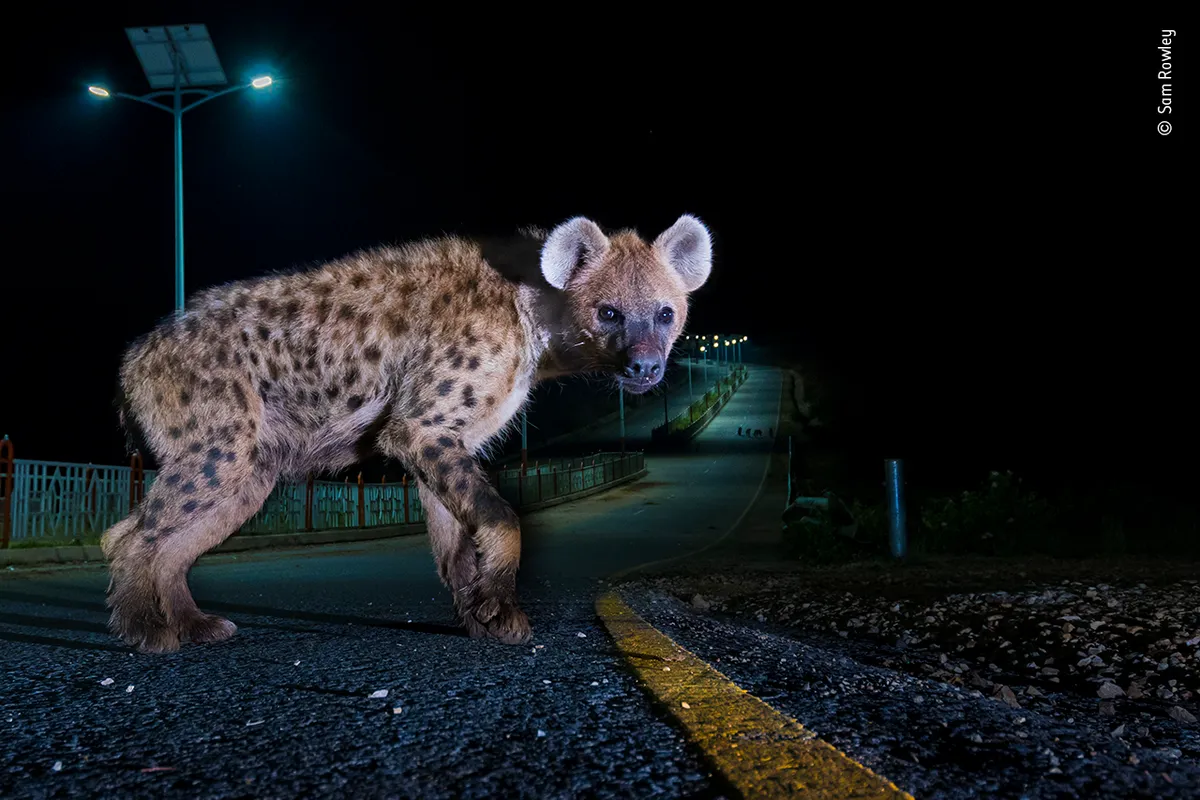
Spotted hyenas are intelligent and opportunistic animals. On the outskirts of cities such as Harar in Ethiopia, they take advantage of what humans leave behind, including bones and rotting meat. In so doing, the hyenas keep disease at bay, and in exchange the Harar locals tolerate them, even leaving them butcher’s scraps.
These hyenas are from the family group known as the Highway Clan. To photograph them, Sam set up a remote camera by a roadkill carcass. He captured the lowest-ranking member of the clan after the dominant members, visible in the background, had sauntered off.
Location: Harar, Ethiopia
Technical details: Nikon D500 + 10–20mm f3.5 Sigma lens; 1/10 sec at f3.5; ISO 1000; Nikon SB-28 flash; Camtraptions remote trigger
That’s the spot! By Richard Flack, South Africa
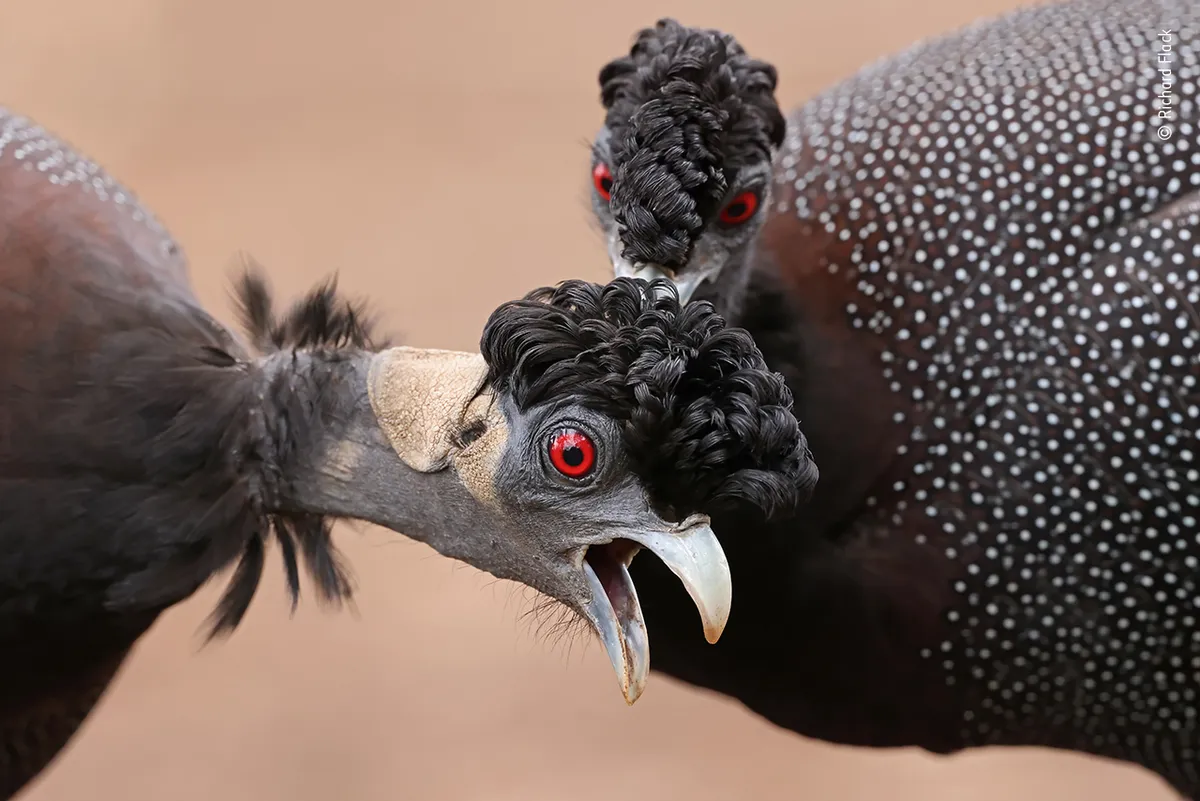
In South Africa’s Kruger National Park, in the vicinity of a rest camp, Richard discovered a flock of crested guineafowl that were not as flighty as normal and allowed him to follow them as they foraged.
One of the guineafowl started to scratch another’s head and ear, and the recipient stood there motionless for a few moments with its mouth open and eyes wide, as if to say ‘that’s the spot, keep going’. Richard muses, ‘It’s not often you get to capture emotion in the faces of birds . . . but there was no doubt – that was one satisfied guineafowl!’
Location: Kruger National Park, Mpumalanga, South Africa
Technical details: Canon R5 + 600mm f4 IS III lens; 1/500 sec at f6.3 (+0.3 e/v); ISO 5000; no flash
Fishing for glass eels by Eladio Fernandez, Dominican Republic
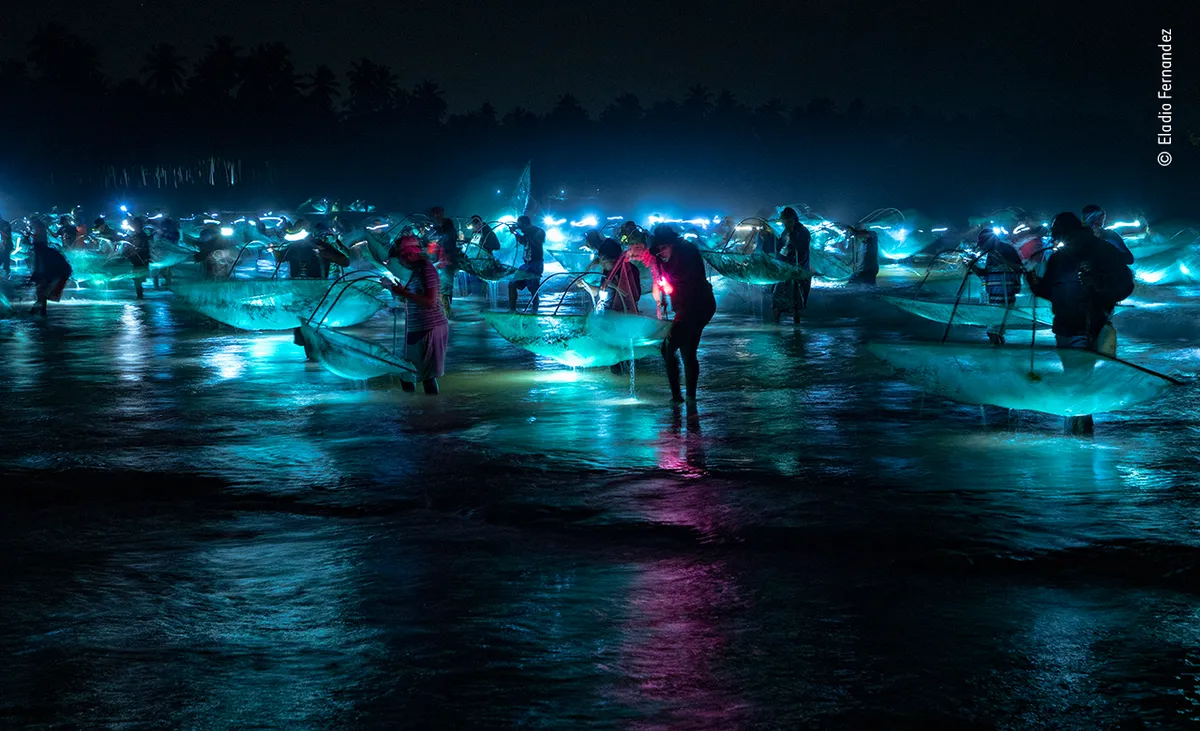
Eladio set out to highlight the plight of the endangered American eel. Caught in its juvenile stage, as glass eels, it is exported in the millions each year to fulfil an insatiable Asian – particularly Japanese – demand. On the coast of the Dominican Republic, over five months, hundreds of fishermen gather around the estuaries from dawn to dusk to catch the little eels.
These larvae have migrated from the Sargasso Sea, where the adult eels spawn. With the species in steep decline, the US fishery is now tightly controlled, leaving the Caribbean to take over as the major exporter but without regulations. The image took Eladio many nights of trial and error, using a long exposure to catch the precise moment that the fishermen raised their nets out of the incoming waves.
Location: El Limon River, El Limon, Dominican Republic
Technical details: Sony 7R III + Metabones adapter + 24–105mm f4 lens; 1/6 sec at f6.3; ISO 1000
A golden huddle by Minqiang Lu, China

Two females and a male golden snub-nosed monkey huddle together to keep warm in the extreme winter cold. Threatened mainly by forest loss and fragmentation, this endangered species is confined to central China. Restricted to living high up in the temperate forests, these monkeys – here in the Qinling Mountains in Shaanxi province – feed mostly in the trees, on leaves, bark, buds and lichen.
Minqiang knew the area where a troop of monkeys often rested and, in heavy wind and snow, he walked up the mountain for almost an hour carrying his photographic equipment. Photographing from a slope opposite the tree in which the group was huddled, he stayed put for half an hour in temperatures of -10°C (14°F) before he was able to achieve this eye-level composition.
Location: Qinling Mountains, China
Technical details: Canon EOS-1DX Mark II + 70–200mm f2.8 lens; 1/800 sec at f4; ISO 320; tripod
Caribbean crèche by Claudio Contreras Koob, Mexico
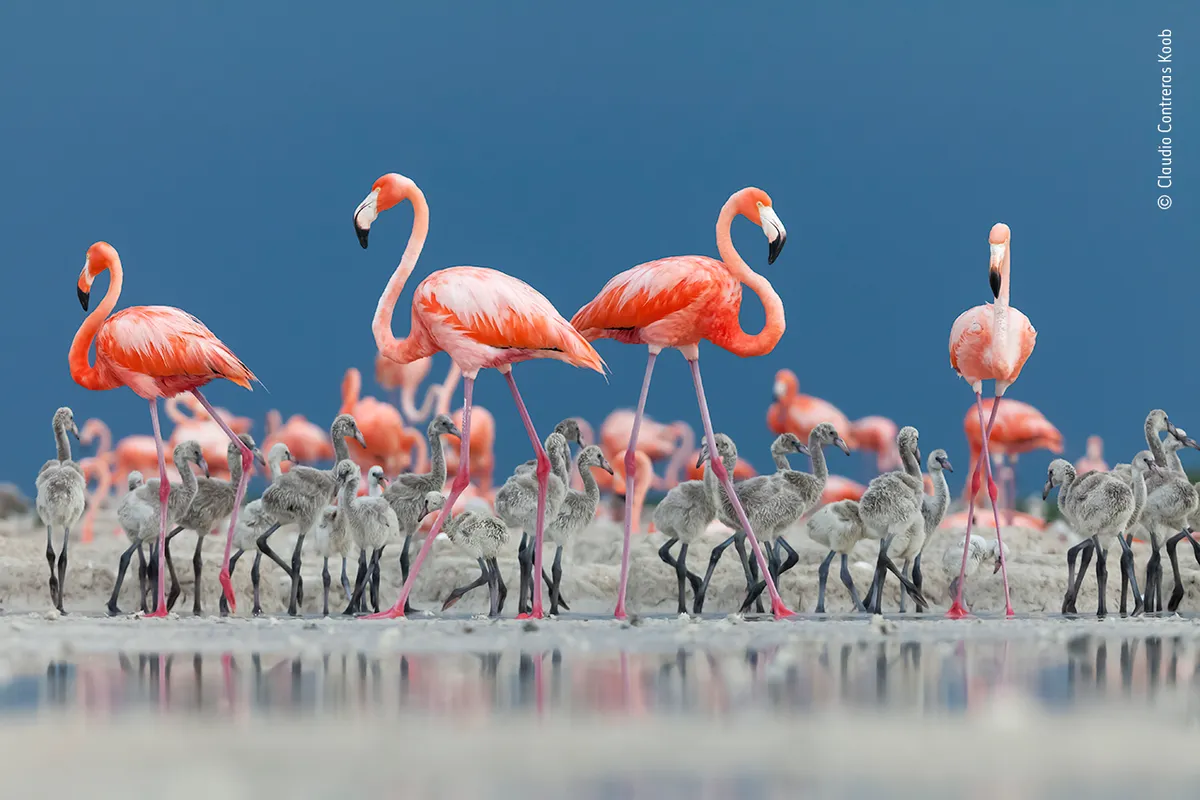
Claudio was lying down on the mud a safe distance from a breeding colony of Caribbean, or American, flamingos, in Ría Lagartos Biosphere Reserve, on the Yucatán Peninsula, Mexico. It was June and the flamingo chicks had already left their nests and were in crèches. These crèches are always guarded by adult birds, so when the chicks began to approach Claudio, the adults surrounded them and gently headed them back into the colony.
Although flamingo population numbers are stable, they are highly sensitive to changes in the environment, such as flooding of their nesting sites, and it is unclear how they will cope with the effects of climate change.
Location: Ria Lagartos Biosphere Reserve, Yucatan, Mexico
Technical details: Canon EOS 5D Mark II + 300mm f2.8 lens + 2x teleconverter; 1/400 sec at f11; ISO 1600
View a gallery of flamingo images from Claudio Contreras Koob’s book.
Wasp attack by Roberto García-Roa, Spain
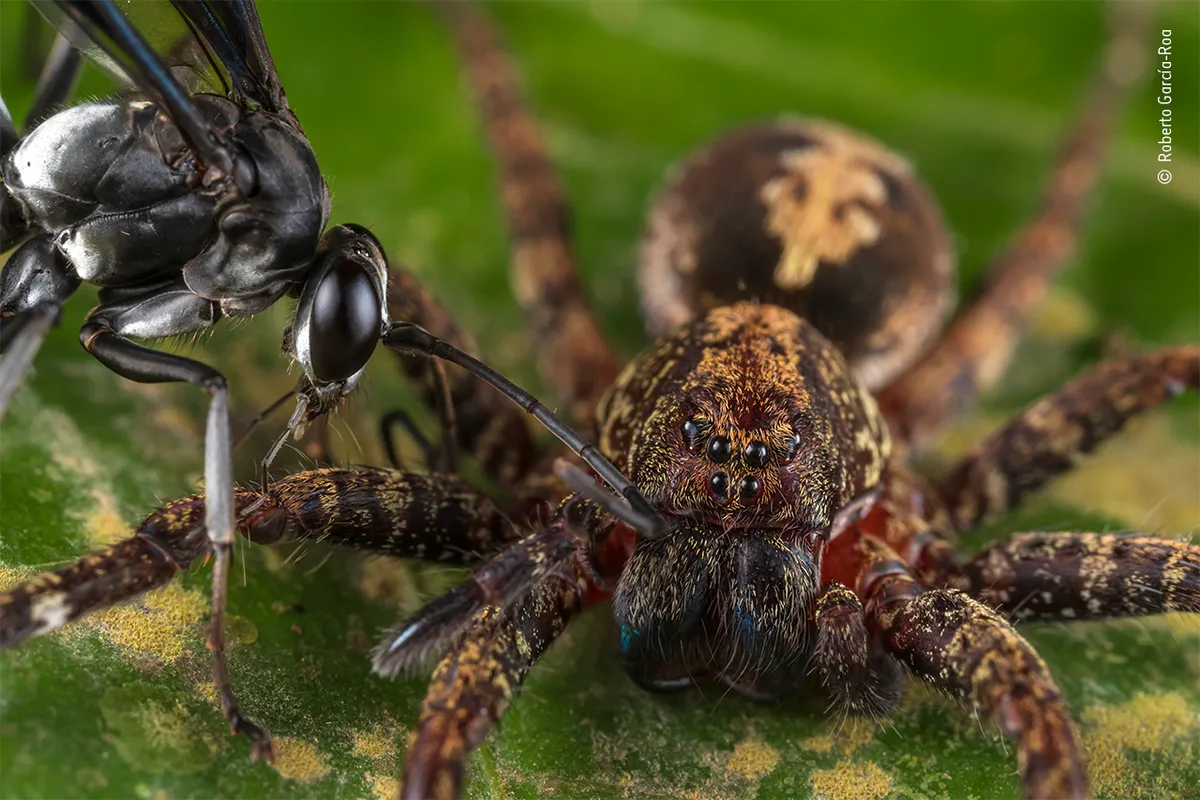
The frenzied combat between the pompilid wasp and the ornate Ctenus spider suddenly stopped. An intense calm invaded the scene, said Roberto, who had been watching the battle unfold in the Peruvian jungle of Tambopata.
The image shows the wasp checking the spider to confirm if its sting has paralyzed the dangerous prey, before dragging it back to its brood nest. Wasps of the Pompilidae family are called spider wasps because the females specialize in hunting spiders, which are used as living food for their offspring.
Location: Tambopata, Madre de Dios, Peru
Technical details: Canon 5D Mark IV + MP-E 65mm f2.8 1–5x Macro lens; 1/200 sec at f14; ISO 500; twin flash with diffuser
Unlucky for the cat by Sebastian Kennerknecht, USA
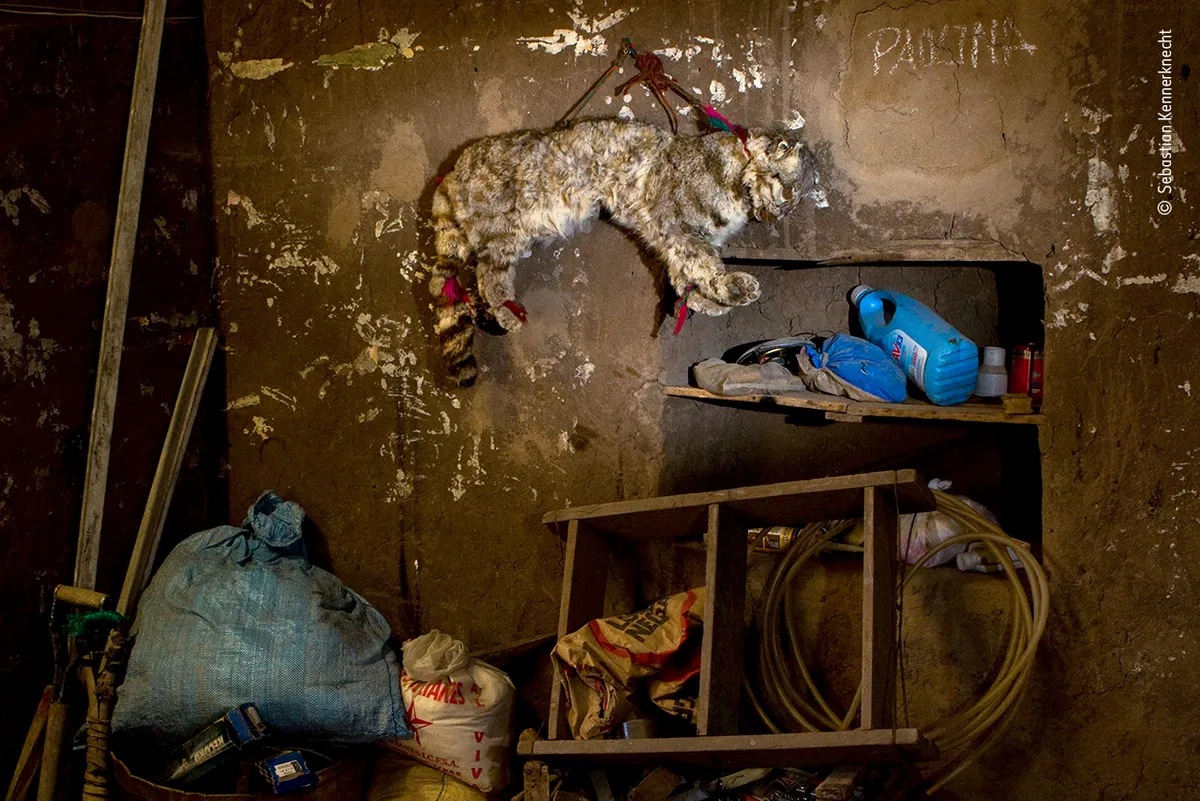
Hanging in a shed this stuffed cat skin may at first appear like the other objects, inconsequential, but the colourful yarns tied to it reveal it is not merely a disused item. The relationship between the Andean cat and its human neighbours is complex.
Though the cats are celebrated as mountain guardians, they are also considered good luck for the fertility of livestock, and for this they are killed and sometimes worn during ceremonies to induce an abundant year. This stuffed specimen turned out to be the closest Sebastian would come to South America’s most endangered wild cat.
Location: Abra Granada, Andes, Argentina
Technical details: Canon EOS-1D Mark IV + 24–70mm f2.8 lens; 1/6 at f11; snooted 680 flash; tripod
Among the flowers by Martin Gregus, Canada

Martin watched this polar bear cub playing in a mass of fireweed on the coast of Hudson Bay, Canada. Every so often the cub would take a break from its fun, stand on its hind legs and poke its head up above the high flowers to look for its mother.
Wanting to capture the world from the cub’s angle, Martin placed his camera – in an underwater housing, for protection against investigating bears – at ground level among the fireweed. He then waited patiently a safe distance away with a remote trigger. Not being able to see exactly what was happening, Martin had to judge just the right moment when the bear would pop up in the camera frame.
Location: Churchill, Manitoba, Canada
Technical details: Nikon D850 + 14–24mm lens; 1/640 at f6.3; ISO 100; Aquatech housing; pocket wizard trigger
The elusive golden cat by Sebastian Kennerknecht, USA
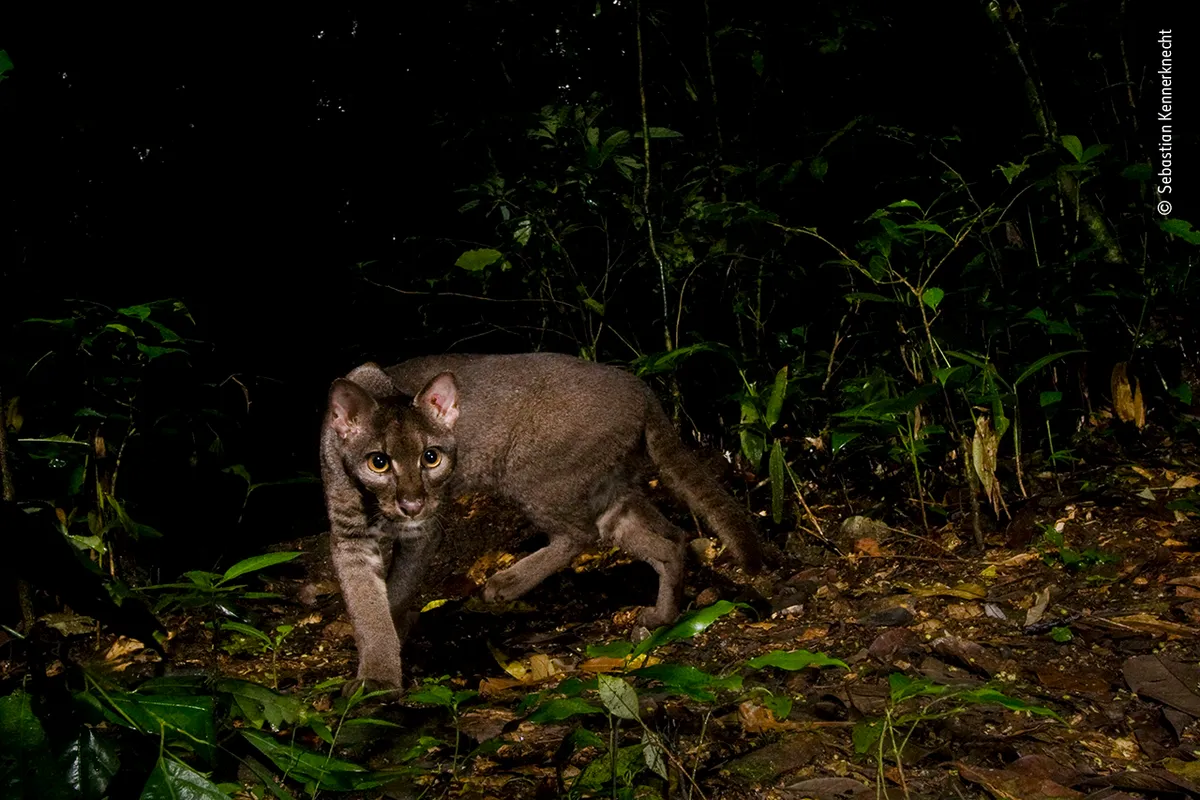
Before this image was captured, Sebastian and his biologist friend, David Mills, were almost trampled in the dense rainforest of Kibale National Park in Uganda by a charging forest elephant.
Returning to the same area, they set up a camera trap with the goal of photographing the rare and elusive African golden cat. About twice the size of a domestic cat, it is one of the world’s least-studied felids. To date, there are still less than five high-resolution photographs of this cat in the wild.
Location: Kibale National Park,Uganda
Technical details: Canon 30D + 10–22mm f3.5–4.5 lens; 1/200 sec at f14; ISO 1000; two Nikon SB-26 flashes; Trailmaster trigger; custom-built waterproof housings
The frog with the ruby eyes by Jaime Culebras, Spain
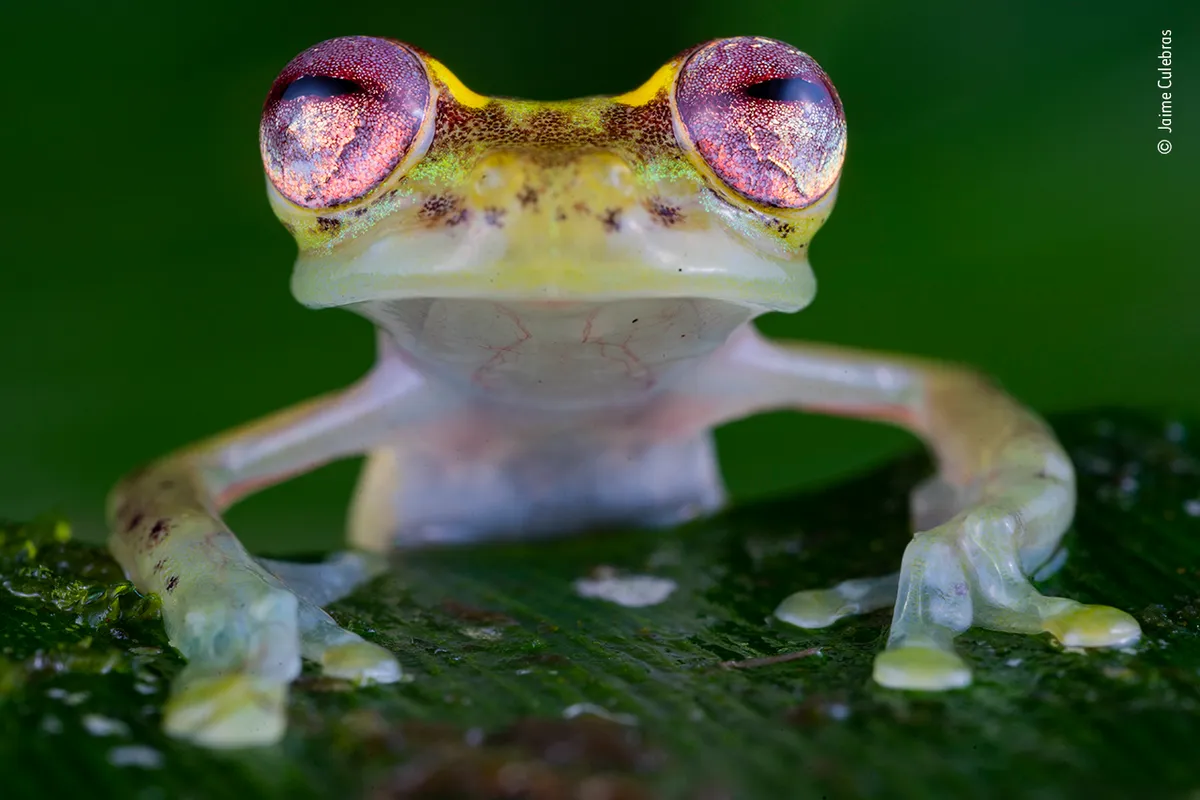
The calls of the male Mindo glass frogs could be heard all around this female, who was sitting quietly on a leaf. These frogs are confident around humans, and if you don't disturb them, you can set up your equipment nearby. Jaime thought this frog had the most beautiful ‘ruby’ eyes, so he carefully moved his camera, tripod and flashes to be close enough to capture a portrait that would highlight them.
Only found in northwest Ecuador, in the Río Manduriacu Reserve in the foothills of the Andes, these frogs are endangered by habitat loss associated with mining and logging.
Location: Rio Manduriacu Reserve, Imbabura Province, Ecuador
Technical details: Sony A7 III + Canon MP-E 65mm f2.8 1–5x macro lens; 1/100 sec at f11; ISO 200; 2x Yongnuo 560IV flashes; 2 Softboxes; Manfrotto 055MF3
Caught by the cat by Michał Michlewicz, Poland

Michał had noticed a lot of animals were visiting this abandoned barn in Radolinek, a small village in western Poland, probably following the scent of rodent prey. With the use of his trail cam, Michał logged a badger, a fox and a marten, but also a lot of cat activity.
Setting up a camera trap just inside the barn, facing the entrance, he waited to see what would trigger it. Luckily, though not for this chaffinch, a domestic cat arrived with its fresh kill. Michał is keen his image is used to illustrate the impact domestic cats can have on a local ecosystem.
Location: Czarnków, Poland
Technical details: Canon 6D + 24mm f2.8 lens; 1/125 sec at f8; ISO 400; 2x Nikon SB-28 flashes; Yongnuo RF603II transmitters; Camtraptions PIR V2 sensor
Head to head by Miquel Angel Artús Illana, Spain

The spectacle of two female muskoxen attacking each other surprised Miquel. For four days, he had been following a muskox family in Norway’s Dovrefjell-Sunndalsfjella National Park – a male, a female and three calves. On a beautiful high plateau, another similar-sized family of muskox appeared.
Expecting a male head-to-head (it was September and the females were in heat), he was disappointed when the two males came to an immediate understanding and the weaker one backed off. It was then that the two females began their short but intense fight, the action of which he caught on camera.
Location: Dovrefjell-Sunndalsfjella-Norway
Technical details: Nikon D850 + 500 mm f5.6 Nikon lens; 1/1600 sec at f8 (+2.3 e/v); ISO 1250
Covid litter by Auke-Florian Hiemstra, Netherlands
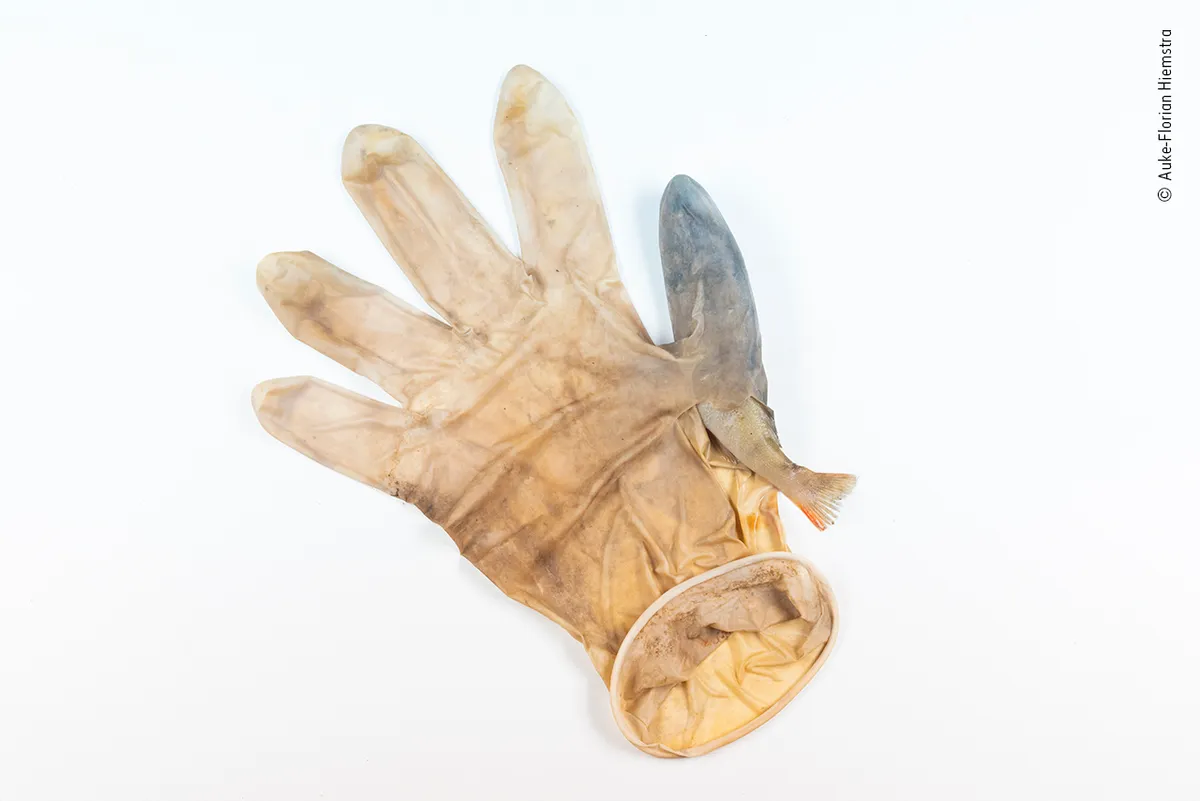
A young perch was found trapped in the thumb of this surgical glove discarded in a canal in The Netherlands. Since the onslaught of Covid-19, gloves and face masks have littered land and sea.
This perch was found by citizen scientists on a weekly canal clean-up in Leiden. The spines on its back prevented the fish from escaping by backing out – the torn thumb probably the sign of its final struggle. The glove formed the basis of a scientific study that has documented the range of animals impacted by Covid-19 waste during the pandemic – in this case, it’s the material that helped protect us that has proved to be a danger to wildlife.
Location: The Netherlands
Technical details: Pentax K1 + 28–70mm f2.8 lens; 1/200 sec at f9; ISO 250; Kaiser studio lights
Life and art by Eduardo Blanco Mendizabal, Spain
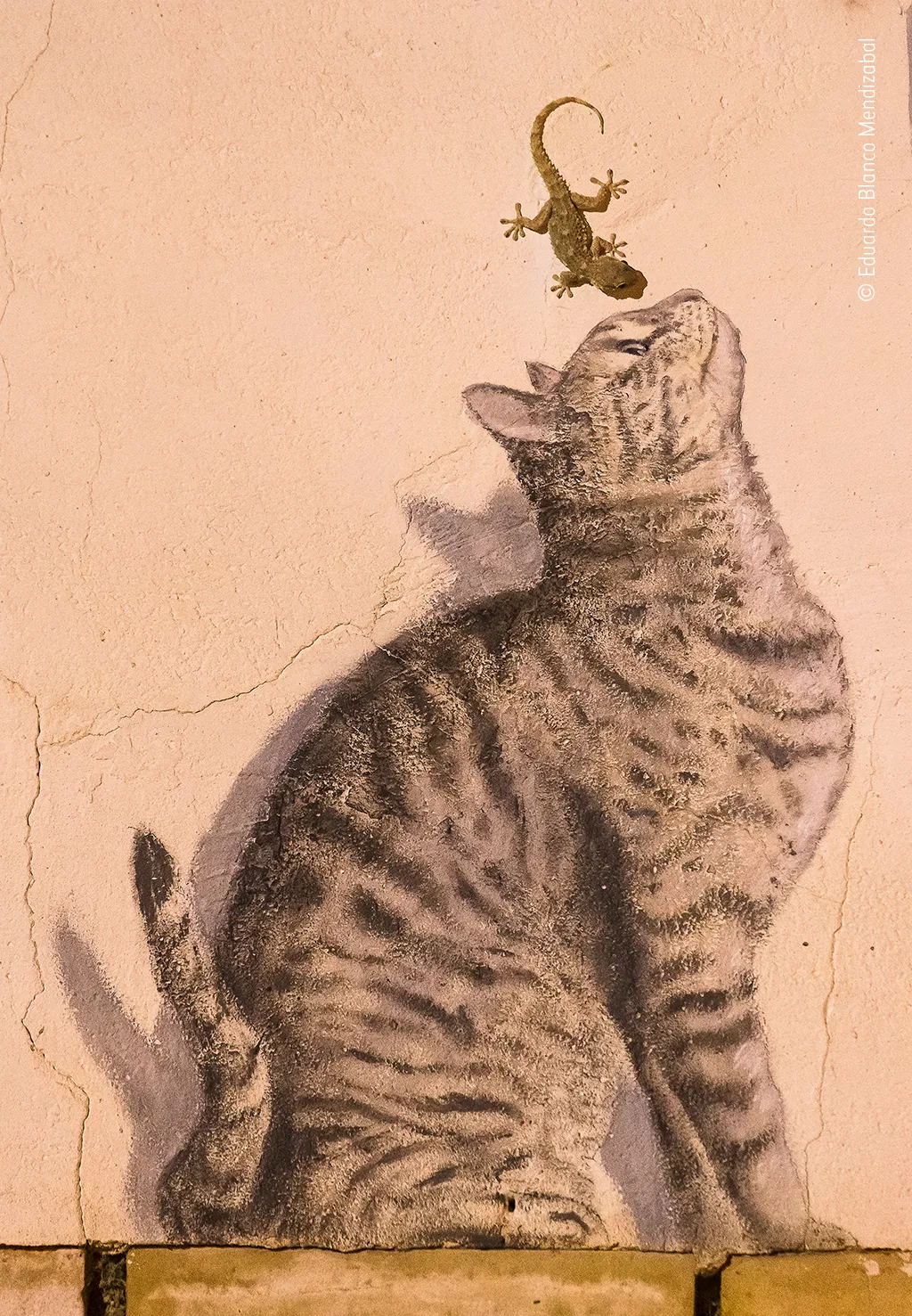
Walking down a street in his hometown of Corella in northern Spain, Eduardo came across a wall with a grafitti cat, complete with shadow. Knowing that common wall geckos emerge on hot summer nights to look for mosquitoes and other insects, Eduardo came back with his camera and waited patiently for the perfect picture – the hunter becoming prey to the trompe l'oeil cat.
Location: Corella, Navarre, Spain
Technical details: Canon R5 + 100-400mm lens; 1/30 sec at f5.6; ISO 6400; tripod
Red and yellow by Chloé Bès, France
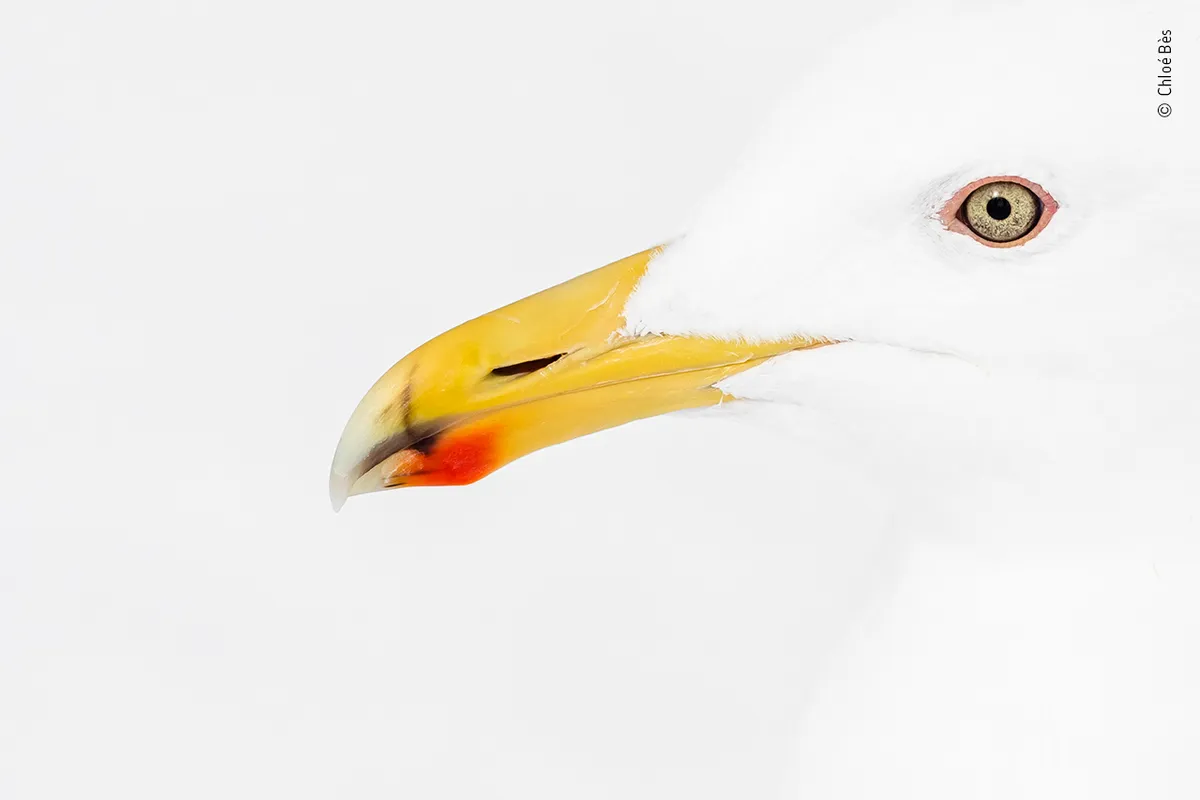
Near Rausu port, on the Japanese island of Hokkaido, several hundred glaucous-winged gulls waited for the return of fishermen. It was the beginning of March and freezing, and the air was full of the raucous calls of the gulls overhead. Some of the birds began to settle, keeping their eyes on the horizon.
Focussing on one bird, Chloé composed a minimalist portrait, highlighting the eye and the beak. The red spot on the beak develops when gulls are adult and is in part a reflection of their health. It is also an essential aid for the young: when chicks peck the spot, it triggers a regurgitation reaction from the parent.
Location: Rausu, Hokkaido Island, Japan
Technical details: Canon 5D Mark IV + 300mm f2.8 lens; 1/3200 sec at f5.6 (+0.33 e/v); ISO 320
Holding on by Igor Altuna, Spain
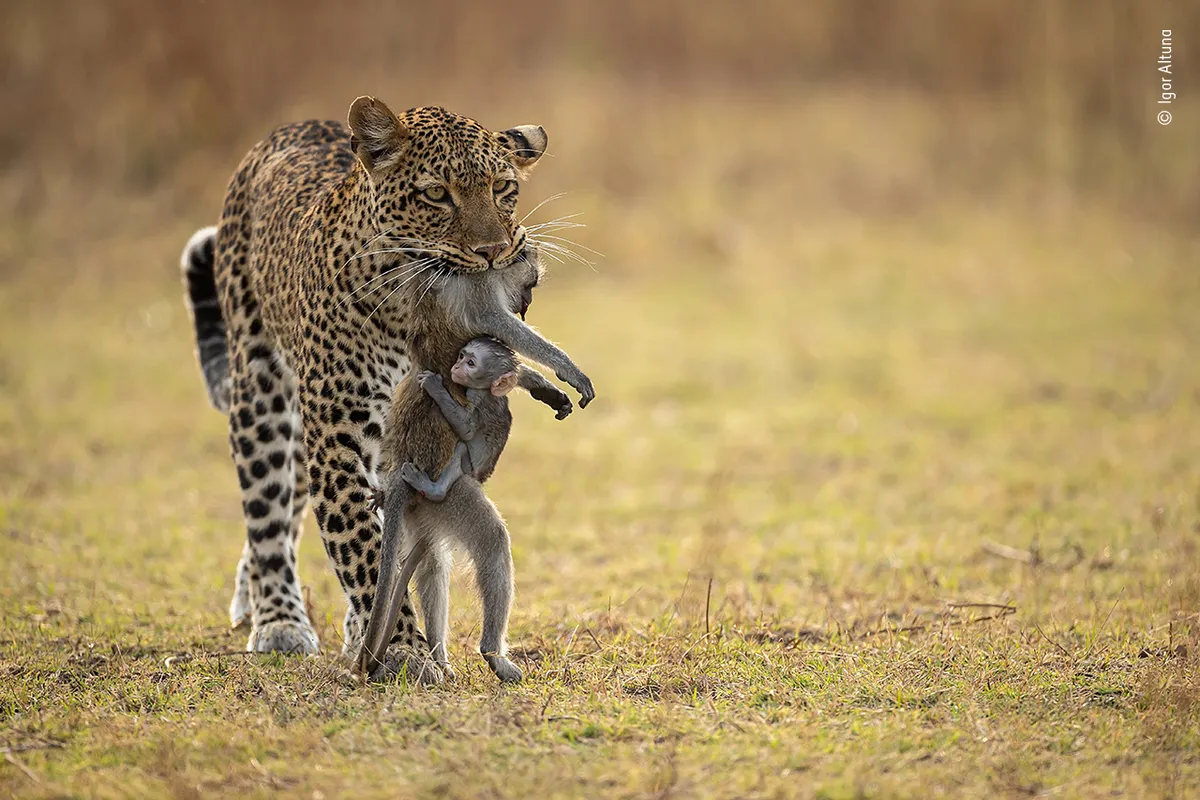
This leopardess had killed a Kinda baboon in Zambia’s South Luangwa National Park. The baboon’s baby was still alive and clinging to its mother. Igor watched as the predator walked calmly back to her own baby. Her cub played with the baby baboon for more than an hour before killing it, almost as if it had been given live prey as a hunting lesson.
Location: South Luangwa National Park, Zambia
Technical details: Canon EOS-1D X Mark III + 600 mm f4 lens; 1/2500 sec at f4; ISO 800
Heads or tails? by Jodi Frediani, USA

The unusually clear, flat sea in Monterey Bay, California, provided a beautiful turquoise backdrop for the glossy bodies of three northern right whale dolphins. But it was only thanks to a thoughtful stranger that Jodi got her special shot of two adult heads and the silvery tail of a juvenile.
Seeing Jodi's interest and camera, the young woman gave up her place at the bow of the boat below which the dolphins were enjoying riding the bow wave. These dolphins are atypical in appearance, with short, pointy beaks, sloping foreheads and no dorsal fins. They are quick and extremely athletic, often flying high out of the water in graceful leaps.
Location: Monterey Bay National Marine Sanctuary, Monterey Bay, California, USA
Technical details: Canon EOS 7D Mark II + Canon EF 24–105mm f4 II lens; 1/1600 sec at f6.3; ISO 6400
Portrait of Olobor by Marina Cano, Spain

It was late afternoon when Marina found Olobor resting. He is one of the famous five-strong coalition of males in the Black Rock pride in Kenya’s Maasai Mara National Reserve.
All around the lion, the ground was black, having been burnt by local Maasai herdsmen to stimulate a new flush of grass. Marina wanted to capture his majestic and defiant look against the dark background and lowered her camera out of her vehicle to get an eye-level portrait.
Location: Masai Mara, Kenya
Technical details: Canon EOS-1D X Mark III + 600mm
f4 lens; 1/800 sec at f8; ISO 800
Coastline wolf by Bertie Gregory, UK
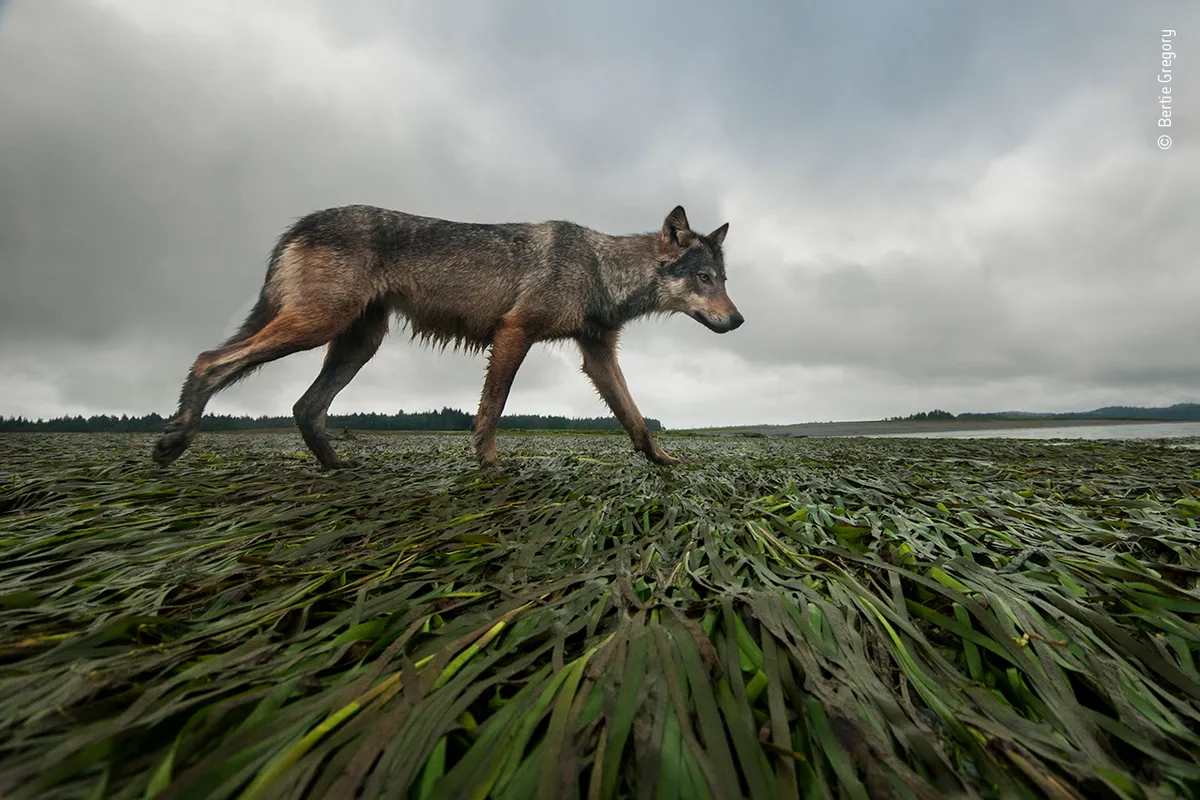
While out in his dinghy looking for black bears, Bertie spotted this female grey wolf trotting along the shoreline on the west coast of Vancouver Island, British Colombia, Canada. Taking a big wide arch, he looped around ahead of where he expected her to go.
He then set up his remote camera, before getting back in the dinghy and backing off. The wolf was patrolling her eel-grass-covered mudflat territory at low tide, and walked right past the camera, allowing Bertie to take this shot with the remote trigger. Sadly, this Vancouver Island wolf was later killed by a man who claimed to be protecting people’s pets.
Location: Vancouver Island, British Columbia, Canada
Technical details: Nikon D300 + 10–20mm f4.5–5.6 lens at 12mm; 1/400 sec at f9; ISO 400; Pocket Wizard wireless trigger; custom-made protective camera housing
Night encounter by Sami Vartiainen, Finland

It was late in the evening in August, and the air had a magical feel about it when Sami spotted this badger close to its sett in a forest near Helsinki, Finland. He watched it for 45 minutes. The badger didn’t seem to be perturbed, even though Sami was only about 7 metres (23 feet) away.
It sniffed the air, lay on the ground and scratched or walked a short distance away, and a few times went into its sett, always turning to look back in Sami's direction. Finally, when it was virtually dark, the badger headed off into the night in search of food.
Location: Helsinki, Finland
Technical details: Canon EOS-1D X + 70–200 f2.8 IS II lens at 105mm; 1/20 sec at f2.8; ISO 3200; tripod
Snowshoe hare stare by Deena Sveinsson, USA
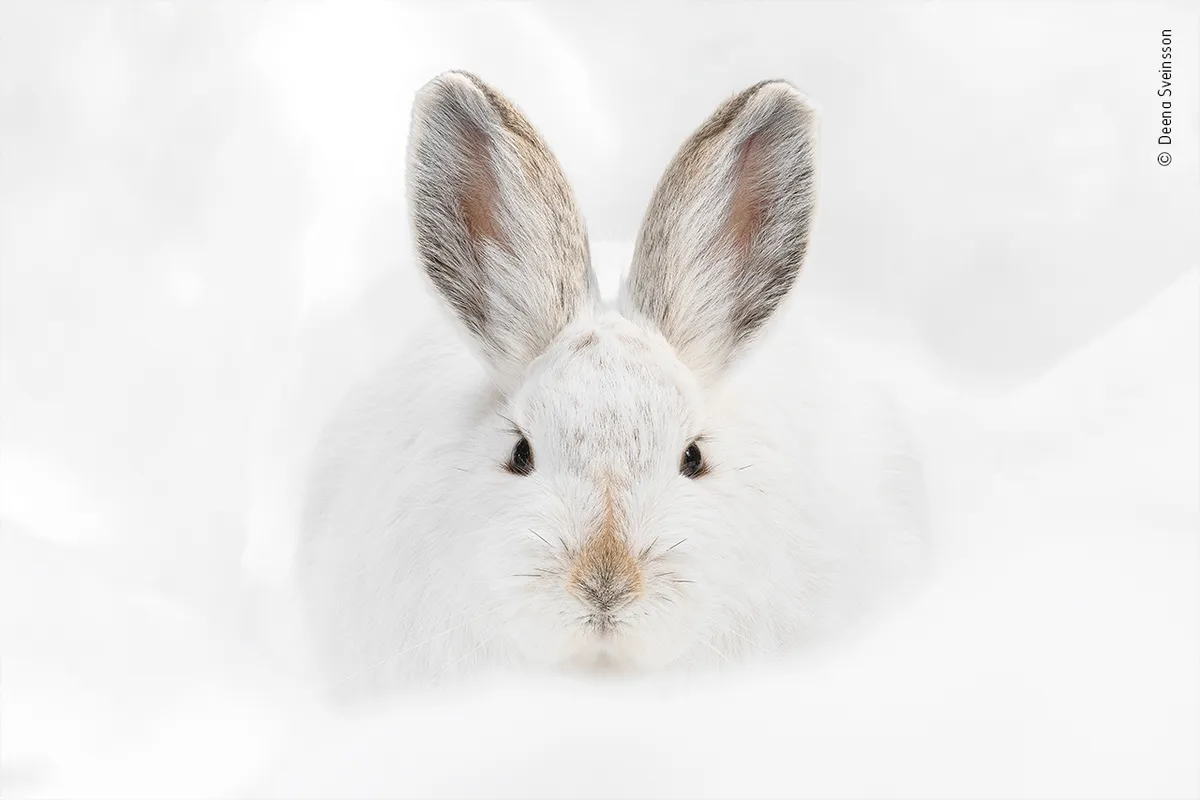
Deena was snowshoeing deep in the forests of the Rocky Mountain National Park, Colorado, in the US, hoping to find some winter wildlife to photograph. Frozen, she reluctantly headed for home.
Only then did something catch her eye – a snowshoe hare resting on a small mound of snow. Moving stealthily into position, Deena waited. Finally, the hare sensed something, turned its ears forward and looked right at the camera.
Location: Rocky Mountain National Park, Estes Park, Colorado, USA
Technical details: Nikon D500 + 200–400mm f4 lens; 1/40 sec at f11 (+2 e/v); ISO 400; shutter release; Gitzo tripod
Fox affection by Brittany Crossman, Canada

On a chilly day in North Shore on Prince Edward Island, Canada, a pair of red foxes, greet one another with an intimate nuzzle.
The red fox’s mating season is in the winter, and it is not uncommon to see them together prior to denning. This special moment is one of Brittany’s favourite images and one of the tenderest moments she has witnessed between adult foxes.
Location: North Shore, Prince Edward Island, Canada
Technical details: Canon 5D Mark IV + 500mm lens; 1/1600 sec at f7.1; ISO 2000
A tight grip by Nicholas More, UK
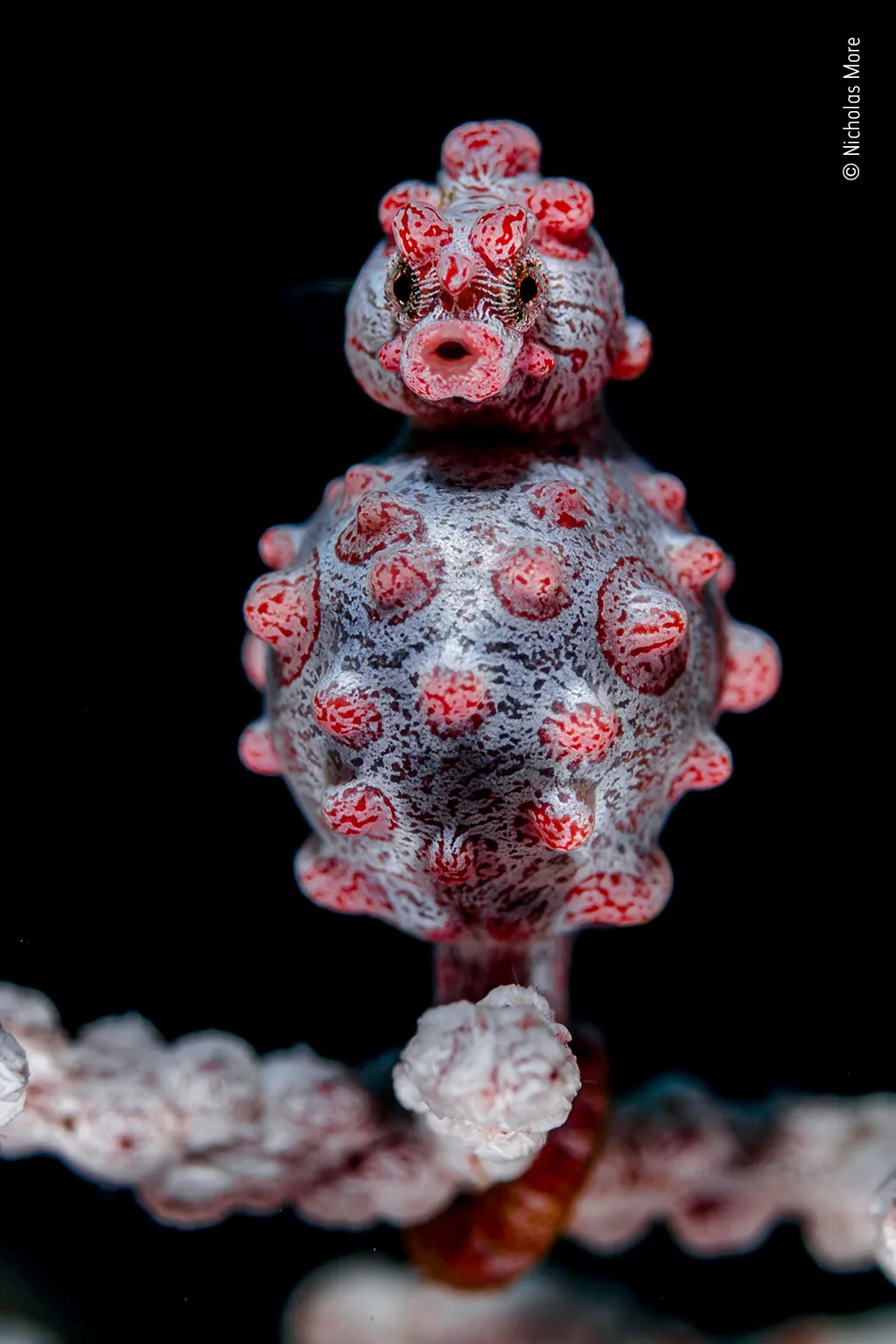
This male Bargibant's seahorse, gripping tightly with his prehensile tail to a pink sea fan, looks almost ready to pop. He will gestate for a period of approximately two weeks before giving birth to miniature live young.
Nicholas had the help of a guide who knew exactly where off the coast of Bali and on which sea fans to find Bargibant's seahorses. This individual was one of three on the same sea-fan. Bargibant's seahorses are barely visible due to their tiny size (1–2 centimetres tall – ¼ to ¾ inch) and tend to stay very still. Their ability to mimic their host's colours and knobbly texture is only revealed in detail under high magnification.
Location: Bali Sea, Tulamben, Bali, Indonesia
Technical details: Nikon D500 + Micro Nikkor 60mm f2.8 lens; 1/320 sec at f11; ISO 100; Nauticam housing + CMC-1 Macro Converter; 2x Inon Z240 strobes
World of the snow leopard by Sascha Fonseca, Germany

Against a backdrop of the spectacular mountains of Ladakh in northern India, a snow leopard has been caught in a perfect pose by Sascha’s carefully positioned camera trap. Thick snow blankets the ground, but the big cat’s dense coat and furry footpads keep it warm.
Sascha captured this image during a three-year bait-free camera-trap project high up in the Indian Himalayas. He has always been fascinated by snow leopards, not only because of their incredible stealth but also because of their remote environment, making them one of the most difficult large cats to photograph in the wild.
Location: Leh, Ladakh, India
Technical details: Canon EOS 5DS + 24mm f2.8 lens; 1/200 sec at f8; ISO 400; Nikon SB28 flash; Camtraptions wireless triggers
A fox’s tale by Simon Withyman, UK
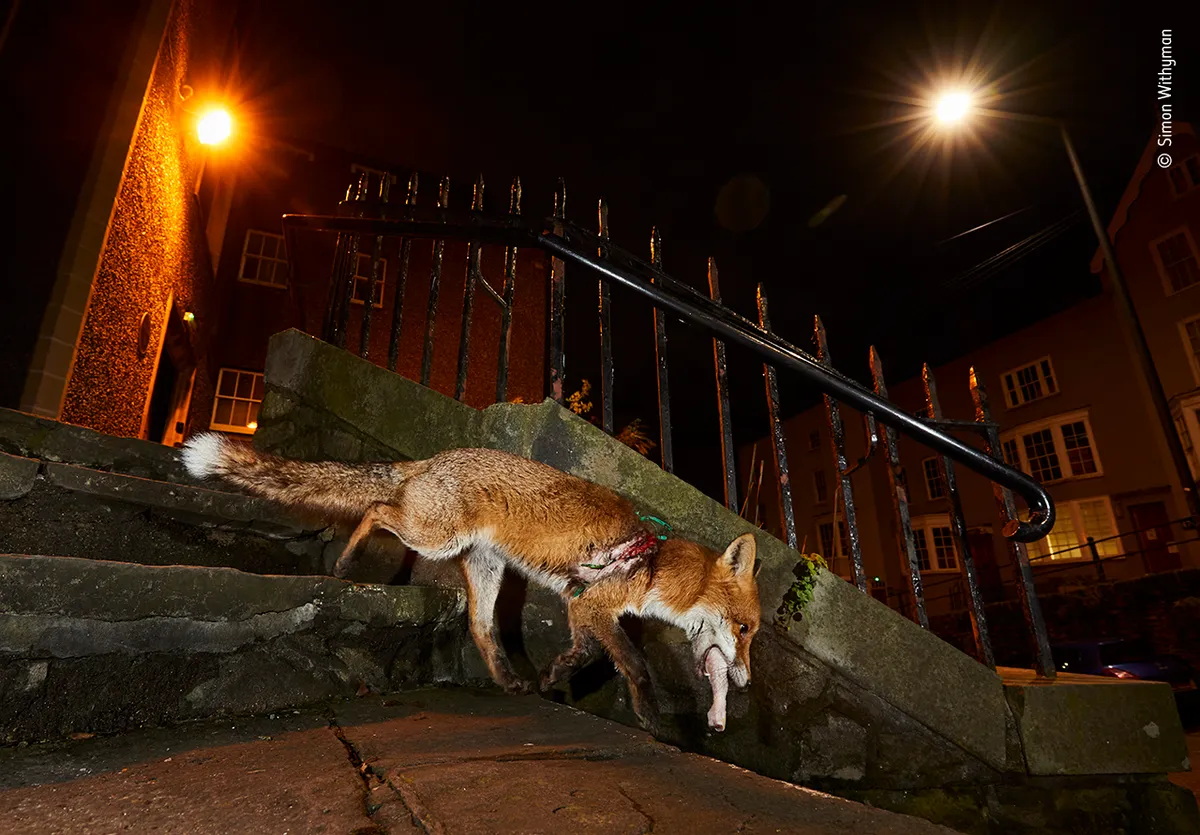
Simon wanted this photograph to raise awareness of the harm humans can inadvertently cause to wildlife. In the UK city of Bristol, a young red fox sustained a serious injury trying to free herself from plastic barrier netting commonly used as fencing on building sites.
The remains were still embedded in her body when this image was taken, hindering her ability to hunt. Local residents left out food for the vixen – here, a chicken leg. After five months, she was caught, treated and released. But tragically, six months later, she was hit by a car and died.
Location: Bristol, UK
Technical details: Canon EOS 5D Mark IV + 16–35mm lens at 16mm; 0.3 seconds at f9; ISO 2500; 2x Profoto A1 flash; Hama wireless remote control
xxx